The latest episode of “Mr. Speaker” (“Herr Talman”), available on Swedish public service channel SVT Play, depicts the Swedish party leaders as war-, cocaine-, nuclear weapons-loving and subservient puppets of the Wallenberg financial dynasty and “Sleepy Joe” Biden’s USA.
According to the creators, the televised puppet show “takes an irreverent humorous approach to politics with satirical puppet versions of our party leaders. Through sketches and songs, the show pokes fun at the political theater, the shortcomings of party leaders, and current issues”.
The show’s creator, Michael Lindgren, is perhaps best known to the Swedish public as a member of the humor group Grotesco and as his alter-ego DJ Trexx performing the acclaimed break-time entertainment number Tingeling during Melodifestivalen in 2009. He is also the man behind the news satire program Svenska Nyheter, also broadcast on SVT and now in its 12th season.
Together with acclaimed comedian Henrik Dorsin and others, Lindgren runs the historic Scala Theatre in Stockholm, founded in 1915, as well as the production company Scala Produktion AB, which has brought the puppet show to TV.
– We look at politics and its celebrities but take great liberties with reality and joke around a lot. It’s very exciting to work with puppets, it allows us to go far, says Lindgren according to the Scala Theatre website.
The series premiered in 2022 and was broadcast in 16 episodes. When it was time for a second season premiere last Friday, no effort was spared when it came to making fun of the Swedish establishment. The episode takes place during the parliament’s Easter celebrations, where prime minister Ulf “Uffetuffe” (roughly meaning “Tough Ulf”) Kristersson wants to celebrate Easter and take credit for Sweden’s NATO accession.
Rewarded by Wallenberg
The celebration doesn’t go according to plan, however, when the ambitious and perpetually confirmation-seeking “Uffetuffe” expects to receive congratulations and best wishes for the new NATO membership from his European colleagues, who are joining the celebration via video link. Instead, he is greeted by a pride-flag-burning Orbán who “doesn’t want anything to do with that bitch Elf from the pussy moderates in gay Sweden”, a pissed-off Erdogan and the customarily confused “Sleepy Joe” Biden with the nuclear button at the ready.
The only one who actually congratulates “Uffetuffe” on the achievement of NATO membership is Russian President Vladimir Putin, who, after hacking the video link, tells Uffetuffe about the Russian proverb that says “even if a small short beetroot seeks shelter in the world’s largest borscht factory, it will be crushed”.
Suddenly a sound is heard, which (former Swedish prime minister) Magdalena Andersson immediately identifies as “Jacob Wallenberg’s helicopter”. After an introduction by Uffetuffe in the form of “he owns like half the stock market, he is my great idol”, Jacob Wallenberg enters the stage and says about the NATO accession that:
“This is a teamwork in the parliament that we are of course not part of. Just because I own a lot of arms industry, it is not for me to decide whether we should join a lucrative arms alliance or not. But, as a sign of my appreciation, all the politicians in here now have a goodie truck waiting in the parking lot with some products from companies in the Wallenberg sphere”.

Cocaine party
Later in the party, when Uffetuffe is sad that the world has not given him the recognition he hoped for, Wallenberg comforts him by saying that his strength lies in his submissiveness and ability to endure humiliation. “We would never have joined NATO if you hadn’t let Turkey and Hungary pee in your face so much”, Wallenberg consoles Uffetuffe.
With these encouraging words, Wallenberg leaves the party by activating his cloaking device and disappears. Swedish Left party leader Nooshi Dadgostar notes that it’s five o’clock and the journalists have gone home, which means only one thing – a coke party!
The party leaders then join in singing “President Dement”.
English lyrics to “President Dement”
We are with the good guys now
Protected by Article 5
Captain America
Is now standing guard at our home
It may be dangerous you say
to tease the Russian bear but
I don’t care
I don’t care
Now we hang out with the USA
We send Swedish kids to the edge of war
In some desert country
Sleepy Joe is great
But maybe a little forgetful sometimes
Our boss is demented
But he has nuclear weapons
President Demented
Mother Sweden’s friend
President Demented
Tell us Sleepy Joe
Where are you going to move the troops?
Should we march on Moscow?
After you take your nap?
Yeah, that would be pretty nice.
Oppenheimer with Alzeimer
He has a timer on the stove
He’s lost and on the ice
Does he wear spikes when he jogs?
The blood is clogging in his brain
Our boss is demented
But he has nuclear weapons
President Demented
Mother Sweden’s friend
Then it will be Donald Trump
































































